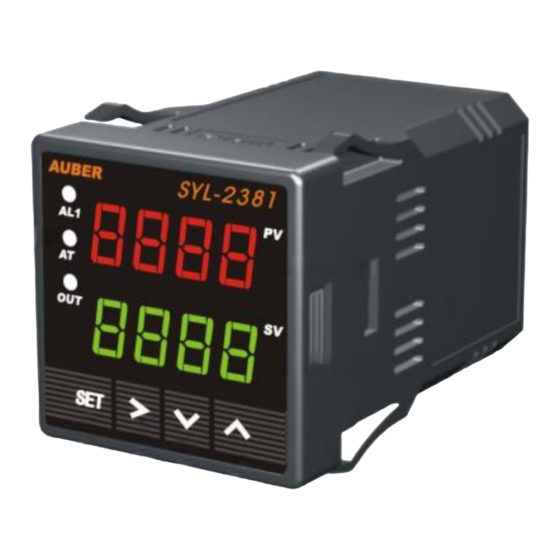Auber Instruments SYL-2381-mA Інструкція з експлуатації - Сторінка 4
Переглянути онлайн або завантажити pdf Інструкція з експлуатації для Регулятор температури Auber Instruments SYL-2381-mA. Auber Instruments SYL-2381-mA 7 сторінок.

AUBER INSTRUMENTS
Table 4. Control parameters.
Symbol
Description
Proportional Band
bb
bb
Range Limit
SouF
SouF
Damp Constant
ot
Control Cycle
ot
FILt
Digital Filter Strength
FILt
End
End
Exit
Note 10. Proportional Band Range Limit (bb): This parameter sets a temperature
range in which the Proportional Constant (P) functions. If the absolute value of the
difference between PV and SV is greater than bb, the proportional output will
always be 100%. If a user wish to use parameter bb to fine tune the performance
of the controller, the value of bb should be smaller than the value of P. By default,
bb is set to 300 degrees.
Note 11. Damp Constant (SouF): This constant can help the PID controller further
improve its control quality. It uses the artificial intelligence to dampen the
temperature overshot. When SouF is set to a small value, the system may
overshoot; when SouF is set to a high value, the system will be over-damped.
Figure 4. Using damp constant to adjust the control results.
Note 12. Control Cycle (ot): It is a time period setting (unit in seconds) that decide
how often does the controller calculates and changes its output. A smaller ot can
result in a better control precision. However, when using the relay output or control
an external relay/contactor, set ot to a small value will operate the relay frequently
and shorten the its life. When Outy is set to 1 or 2, set ot to 1 ~ 3 seconds; when
Outy is set to 3, set ot to 20 ~ 40 seconds; when Outy is set to 4 or 5, ot setting is
ignored. Generally speaking, set ot to small value for a fast response system, set
ot to larger value for a slow response system.
Note 13. Digital Filter (Filt): Filt = 0 (default), filter disabled; Filt = 1, weak filtering
effect; Filt = 3, strongest filtering effect. Stronger filtering increases the stability of
the readout display, but causes more delay in the response to changes in
temperature.
5.3 Set value setting and alarm setting (accessed by code 0001)
The set value and alarm parameters are listed in Table 5. To change the
parameters, press SET key, enter code "0001", and press SET key again. The
procedures to change control parameters are similar to what is shown in Figure
3.
Table 5. Set temperature and alarm parameters.
Symbol
Target temperature
SV
SV
AH1
J1 pull-in temperature
AH1
AL1
J1 drop-out temperature
AL1
END
END
Note 12. There are two ways to set the target temperature:
2021.05
Setting Range
Initial
1 ~ 1999
0.1 ~ 1.0
1 ~ 500 (sec)
0 ~ 3
Initial
Description
Setting
800
(Set Value)
900
800
Exit
a. In the normal operation mode, press
Note
decrease the SV. Then wait about 4 seconds to allow the controller save the new
SV.
300
10
0.2
11
b. Press SET key once, enter code 0001, the press SET key again to confirm.
2
12
Then the display will flash SV (Su) in the top display. Press the SET key again
0
13
to show the current SV setting in the bottom display. Now use >,
enter the new SV and press the SET key to save the value. Press V key to put
END on the top display, then press SET key to exit; or you can wait about 30
seconds then the controller will return to normal operation mode.
Note 13. Alarm setting (AH1 and AL1). The J1 relay can be set to works as
absolute temperature alarm (when outy = 1 or 5), or as temperature deviation
alarm (when outy = 2).
1) Absolute alarm (outy = 1 or 5)
When J1 works as an absolute temperature alarm, the AH1 is the alarm-on
temperature, AL1 is the alarm-off temperature. When AH1 > AL1, J1 works as an
absolute high temperature alarm: when PV is higher than AH1, J1 relay pulls in;
when PV is lower than AL1, J1 relay drops out. The diagram is shown in Figure 5
to illustrate how it works. When AH1 < AL1, J1 works as an absolute low
temperature alarm. A diagram is shown in Figure 6 to illustrate how it works. When
AH1 = AL1, the alarm is disabled.
2) Deviation alarm (outy = 2)
When J1 is set as a deviation alarm, it will be activated if PV deviates too far
away from the set value (SV). AH1 defines the deviation high alarm, AL1 defines
the deviation low alarm. For the deviation high alarm, when PV is higher than (SV
+ AH1) relay J1 will pull in, when PV drops below (SV + AH1 -Hy) relay J1 will
drop out; for the deviation low alarm, when PV is lower than (SV - AL1) relay J1
will pull in, when PV is higher than (SV - AL1 + Hy) relay J1 will drop out. To
deactivated the deviation high alarm, set AH1 = 0; to deactivated the deviation
low alarm, set AL1 = 0.
Note
12
13
13
WWW.AUBERINS.COM
or V key to directly increase or
Figure.7 J1 relay works as derivation alarms
(SV = 100, AH1 = 20, AL1 = 30, Hy = 10).
and V key to
P4/7
